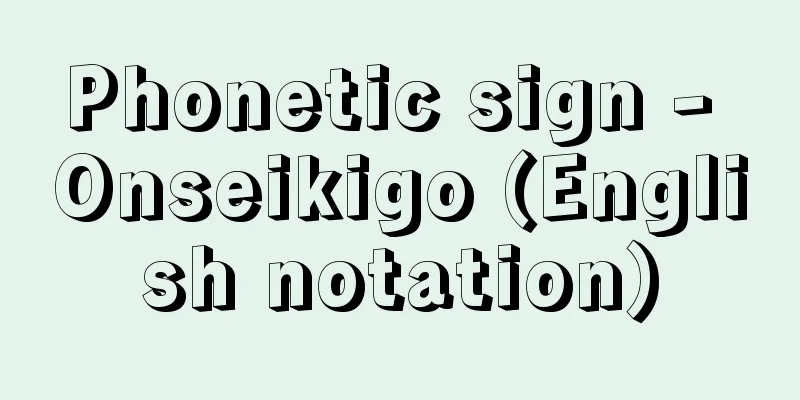Phonetic sign - Onseikigo (English notation)

|
Speech sounds are dynamic phenomena that change from moment to moment. Therefore, in order to preserve them, they must be described using symbols. However, as the British literary scholar Bernard Shaw joked, "fish" can be spelled "ghoti" by connecting only the underlined parts of "rou gh ," " wo men," and "sta ti on," the orthographic characters used in daily life generally have various phonetic values depending on the context, which is extremely inconvenient in that it is not possible to establish a correspondence between one sound and one character. Therefore, symbols that are prepared to describe and analyze speech sounds phonetically on a different level from orthographic characters are called phonetic symbols, and are usually placed in [ ]. Many phonetic symbols have been devised, but they can be roughly divided into non-letter symbols and letter symbols. The former include O. Jespersen's Lehrbuch der Phonetik (1913, 1926) and KL Pike's Phonetics (1943), but because the symbols correspond to the individual articulatory elements that are considered to make up a single phone, for example, [t] is expressed as α,,βO f γ,,δO ε 3ζ+ according to Jespersen, while it is expressed as MaIlDeCVveIcAP p a a t d t1 t n r ansfsSiFSs according to Pike, which is extremely complicated. For this reason, although they are suitable for the precise representation of a single phone, they are not suitable for describing a sequence of single phones. In contrast, the latter is extremely practical in that not only is one symbol made to correspond to one single sound, but it can also describe the quantitative changes in sound (long/short, high/low, loud/soft, etc.). For this reason, many people have created a wide variety of symbols since ancient times, from those that are similar to existing character notations such as the Roman alphabet, to those that use special symbols such as those in Alexander Melville Bell's visible speech (1867). The International Phonetic Alphabet (IPA) was established when Jespersen published a letter to P. Passy, proposing the establishment of a common notation system for all languages to sort out this situation, and was officially first published in the journal of the International Phonetic Association in August 1888. The origins of this notation system lie in palaeotype, invented by AJ Ellis, which appeared after 1899, and romic, which was developed by H. Sweet, and both have practical value in that they are based on simple symbols mainly using the Roman alphabet. For this reason, the IPA has since become the most widely used phonetic alphabet. The IPA distinguishes between "simplified notation," which was established from a practical standpoint in foreign language education and the establishment and revision of orthography, and "precise notation," which uses as many auxiliary symbols as possible to describe even subtle differences at an academic level. However, excessively precise notation can lead to the risk of losing sight of the true nature of language sounds, and phonology was born from this reflection. In Japan, the Phonetic Society of Japan has worked to popularize these symbols, so they are widely used in academic circles, including foreign language education. However, some Russian and English speakers do not follow this, and their own original notations based on orthography are still widely used. There are many issues that need to be addressed in the future, including: (1) the criteria for identifying single sounds and the use of the same symbols for different single sounds, (2) correcting the traditional classification criteria that were based solely on articulatory aspects by taking into account acoustic, auditory, and functional aspects, and (3) taking into consideration applied phonetic aspects such as articulatory clarity. [Jyosei Hyakutaro] "Phonetics" by Shiro Hattori (1984, Iwanami Shoten) " ▽ "Phonetics" by Kotaro Josei and supervised by Haruhiko Kindaichi (1982, Apollon Music Industry Co., Ltd.) " ▽ "Encyclopedia of Phonetics" edited by the Phonetic Society of Japan (1976, Sanshusha) Source: Shogakukan Encyclopedia Nipponica About Encyclopedia Nipponica Information | Legend |
|
言語音は時々刻々と変化する動的現象である。したがって、これを保存するためには、記号を用いて記述しなければならない。しかし、たとえばイギリスの文学者バーナード・ショーが、rough, women, stationの各下線部だけをつなぎ合わせれば、英語のfishを“ghoti”と綴(つづ)ることができると冗談を飛ばしているように、日常用いられている正書法上の文字は、前後の脈絡によっていろいろな音価を有するのが一般であるため、1音1文字の対応関係が成立しない点で甚だ不便である。そこで、正書法上の文字とは異なる次元で、言語音を音声学的に記述および分析するために用意された記号を音声記号といい、通常これを[ ]内に入れる。 音声記号にはこれまで数多くの考案がなされてきたが、ほぼ非字母記号と字母記号に大別される。前者にはイェスペルセンO. Jespersenの『Lehrbuch der Phonetik』(1913、1926)やパイクK. L. Pikeの『Phonetics』(1943)などがあるが、1単音を構成すると目される個々の調音要素に記号が対応しているため、たとえば[t]は、イェスペルセンに従うと、α,,βOfγ,,δOε3ζ+となり、一方パイクに従えば、MaIlDeCVveIcAPpaatdt1tnransfsSiFSsのようになって、きわめて煩雑である。このため、1単音の精密な表記には適していても、単音の連続を記述するのには適さない。これに反して後者では、ほぼ1記号が1単音と対応するようにつくられているだけでなく、音の量的変化(長短、高低、強弱など)をも記述できる点で、きわめて実用的である。そのため、古来多くの人人によってローマ字など既存の文字表記に近いものから、ベルAlexander Melville Bellのvisible speech(1867)に代表されるような特殊な記号を用いるものまで、千差万別の記号が生み出されてしまった。 国際音声字母(IPA)は、このような状態を整理して、あらゆる言語に共通する記述方式の樹立を提案したイェスペルセンのパシーP. Passyあてへの書簡が公表されたのを契機として成立したもので、公式には1888年8月に国際音声学協会の機関誌に発表されたものをもって嚆矢(こうし)とする。この表記法の原点は、1899年以降に登場したエリスA. J. Ellis考案のpalaeotype、およびこれを発展させたスウィートH. Sweetのromicにあるが、いずれもローマ字を中心とした簡素な記号でまにあわせている点に実用的価値がある。このため、以後IPAはもっとも普及した音声記号となっている。 IPAには、外国語教育、正書法の制定ならびに改訂などの実用的見地から定められた「簡略表記」と、学問的レベルで微妙な差異までも可能な限り多種の補助記号を用いて記述し分ける「精密表記」との区別がある。ただし、過度な精密表記は、かえって言語音の本質を見失うおそれがあり、この省察から音韻論が誕生した。日本では日本音声学会がこの記号の普及に努めたため、外国語教育をはじめ、広く学界に用いられている。ただしロシア語および英語関係の一部ではこれに従わず、正書法をもとにした独自の表記がいまでも盛んに行われている。 なお、今後の課題としては、(1)単音の認定基準ならびに異なる単音に対する同一記号の充当、(2)従来の調音面偏重主義に徹した分類基準に対する音響的、聴覚的、機能的側面からの是正、(3)調音明瞭(めいりょう)度をはじめとする応用音声学的側面への配慮など、多くの問題が山積している。 [城生佰太郎] 『服部四郎著『音声学』(1984・岩波書店)』▽『城生佰太郎講・著、金田一春彦監修『音声学』(1982・アポロン音楽工業社)』▽『日本音声学会編『音声学大辞典』(1976・三修社)』 出典 小学館 日本大百科全書(ニッポニカ)日本大百科全書(ニッポニカ)について 情報 | 凡例 |
<<: Speech synthesis - Onsei Gousei (English spelling) speech synthesis
>>: Phonetics - Onsei-gaku (English spelling)
Recommend
Tipu Sultān
1753‐99 A Muslim ruler of a small kingdom based in...
Kamaitachi (Sickle Weasel) - Kamaitachi
A demon said to ride on a whirlwind, slash people,...
Resorcinol
A colorless crystal of 1,3-dihydroxybenzene. Also ...
Public Occurrences, Both Foreign and Domestic
The first newspaper published in America. It was p...
Blind seat - Blind
During the Muromachi period, there were merchant g...
airborne warning and control system
...On the other hand, taking advantage of the fac...
Linga (English spelling) liga
A phallic statue worshipped in India. Phallic wor...
Prague - Praha (English spelling)
The capital of the Czech Republic. It is the coun...
surgical biopsy
...It is mainly used to distinguish between benig...
Isolationism
A foreign policy or international outlook doctrin...
Crossed check - Senbikikogitte (English spelling) Crossed check
A check with two parallel lines drawn on the fron...
Real Estate - Fudosan
Land and its fixtures (Civil Code, Article 86, Pa...
Coenobitidae
…General term for crustaceans belonging to the de...
《Goodnight Irene》 - Goodnight Irene
…Early modern folk songs thus had a strong social...
Otto III
980‐1002 The fourth Saxon king of Germany. Reigned...

![Shimosuwa [town] - Shimosuwa](/upload/images/67cbcb5d3f465.webp)







